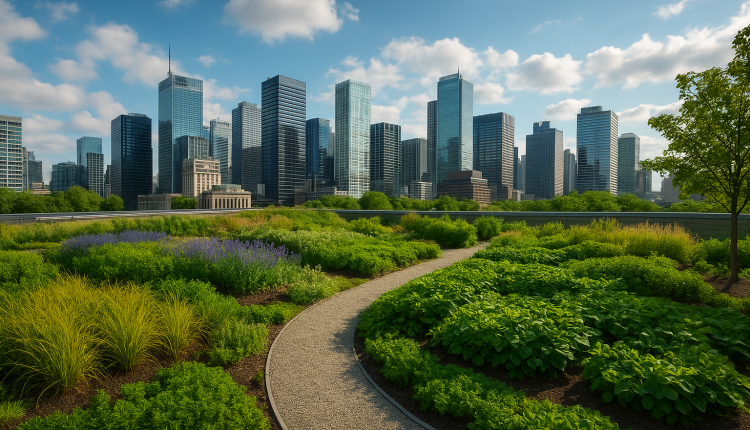- Advertisement -
As global temperatures continue to rise, urban areas are experiencing an alarming increase in heat-related challenges. Concrete, asphalt, and glass dominate modern cityscapes, trapping and radiating heat — a phenomenon known as the urban heat island effect. This effect can make cities several degrees warmer than surrounding rural areas, intensifying heat waves and putting additional strain on energy systems and human health. However, an elegant and sustainable solution is growing across rooftops, balconies, and community spaces: urban gardens and green roofs. These green infrastructures not only enhance city aesthetics but also play a vital role in cooling environments, improving air quality, and supporting climate resilience.
The Science Behind Urban Heat Islands
To understand how greenery mitigates urban heat, it’s important to look at the mechanics of the urban heat island effect. Materials commonly used in city construction — concrete, metal, asphalt — absorb sunlight and slowly release it as heat, raising local temperatures even after sunset. At the same time, the absence of vegetation reduces natural cooling mechanisms like evapotranspiration, where plants release water vapor that helps moderate temperature.
When vegetation is reintroduced to urban landscapes, this natural cooling process returns. Plants absorb sunlight for photosynthesis, use water for evaporation, and shade surfaces, all of which combine to lower ambient temperatures. Studies have shown that green roofs can reduce rooftop surface temperatures by up to 30–40°C compared to conventional roofs, significantly reducing indoor heat loads.
Green Roofs: Cooling from Above
Green roofs transform otherwise barren rooftops into living ecosystems. They consist of layers — waterproof membranes, soil substrates, and vegetation — designed to sustain plant growth while protecting buildings. Depending on the depth and plant types, green roofs can be either extensive (lightweight, with low-maintenance grasses or succulents) or intensive (deeper soil layers supporting shrubs and even small trees).
The benefits of green roofs go beyond aesthetics. By acting as thermal buffers, they keep buildings cooler in summer and warmer in winter, lowering energy consumption for air conditioning and heating. This, in turn, reduces greenhouse gas emissions from electricity use. Additionally, green roofs capture rainwater, easing the pressure on urban drainage systems and mitigating flood risks during storms.
Moreover, these elevated gardens enhance biodiversity. Birds, insects, and pollinators find refuge among the greenery, creating small yet vital habitats amid the concrete jungle. For many urban residents, green roofs also offer accessible green spaces for relaxation, urban farming, or social interaction — improving both environmental and mental well-being.
Urban Gardens: Ground-Level Solutions with Global Impact
While green roofs address the heat problem from above, urban gardens tackle it from the ground. Vacant lots, sidewalks, and community spaces can be converted into small oases of vegetation, reducing heat and bringing life back into city neighborhoods. These gardens can range from community plots to vertical walls and even micro-parks along city streets.
Urban gardens serve multiple purposes: they reduce surface temperatures, absorb carbon dioxide, and improve air quality by filtering pollutants. They also strengthen local food systems by providing fresh produce within walking distance, reducing the carbon footprint associated with food transportation.
Beyond their environmental benefits, urban gardens foster social connections. Shared gardening projects encourage collaboration and community engagement, promoting a sense of stewardship and environmental awareness among city dwellers. Such spaces are often associated with reduced crime rates and better mental health outcomes, showing that greenery not only cools the air but also nurtures human connections.
Climate Adaptation Through Urban Greenery
As climate change continues to affect weather patterns, cities must adapt quickly to protect residents from extreme heat and flooding. Green roofs and urban gardens are integral to nature-based solutions — strategies that leverage natural systems to build climate resilience.
In regions experiencing intense heatwaves, greenery helps reduce mortality rates and improve air quality. By lowering temperatures and humidity levels, green infrastructure minimizes heat stress for vulnerable populations. Additionally, the carbon sequestration ability of plants contributes to long-term climate mitigation, while stormwater absorption reduces the frequency of flash floods caused by heavy rainfall events.
Cities like Singapore, Copenhagen, and Toronto have already implemented extensive green roof policies and urban greening initiatives. Their success demonstrates that even densely populated urban environments can integrate vegetation to balance modern development with ecological sustainability.
Implementing Green Roofs and Gardens: Practical Tips
For individuals, businesses, or municipalities interested in greening their urban spaces, starting can be simpler than expected.
1. Assess the Space:
For rooftops, structural assessment is essential to ensure the building can support the additional weight of soil and plants. Lightweight, drought-resistant species are ideal for most extensive roofs.
2. Choose the Right Plants:
Native and hardy species require less water and maintenance. Sedum, grasses, and small flowering plants thrive on rooftops, while shade-tolerant shrubs and herbs are perfect for ground-level gardens.
3. Manage Water Wisely:
Installing irrigation systems or using collected rainwater ensures plants remain healthy even during dry periods. Sustainable designs integrate drainage layers that prevent excess water buildup.
4. Encourage Community Involvement:
Community gardens thrive when residents participate in planting and maintenance. Public engagement ensures long-term success and builds a sense of collective responsibility toward the environment.
5. Integrate with Policy:
City planners can incorporate green roofs and urban gardens into zoning regulations, offering tax incentives or grants for eco-friendly construction. Mandating a percentage of rooftop greenery in new developments has already proven successful in cities such as Paris and New York.
Conclusion: Greening the Future of Cities
Urban gardens and green roofs represent more than just an aesthetic improvement — they are vital tools in the fight against climate change and urban overheating. By restoring natural cooling mechanisms, filtering the air, and providing habitats for biodiversity, these systems help cities become more livable and resilient.
As climate challenges grow more urgent, the transformation of urban environments into green, breathing ecosystems is no longer optional — it is essential. Whether through a rooftop meadow, a pocket park, or a shared community garden, each patch of greenery contributes to a cooler, cleaner, and healthier future for all.

